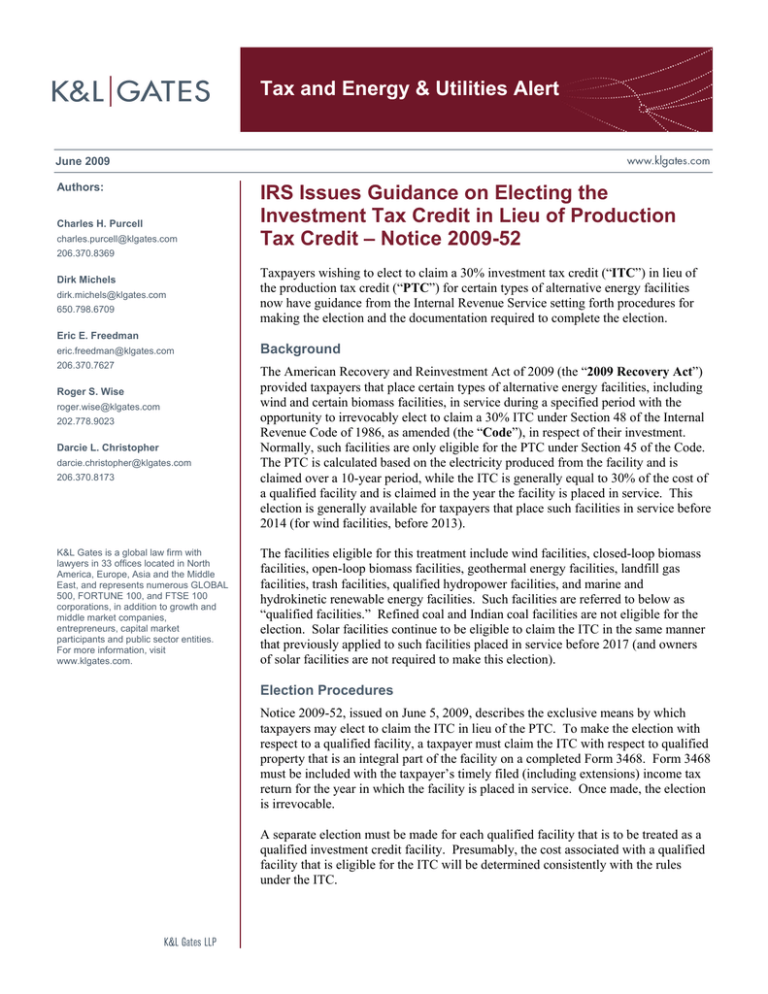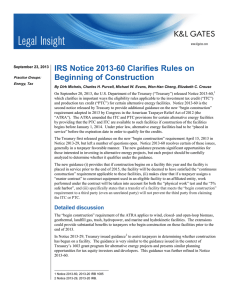
Tax and Energy & Utilities Alert
June 2009
Authors:
Charles H. Purcell
charles.purcell@klgates.com
206.370.8369
Dirk Michels
dirk.michels@klgates.com
650.798.6709
Eric E. Freedman
IRS Issues Guidance on Electing the
Investment Tax Credit in Lieu of Production
Tax Credit – Notice 2009-52
Taxpayers wishing to elect to claim a 30% investment tax credit (“ITC”) in lieu of
the production tax credit (“PTC”) for certain types of alternative energy facilities
now have guidance from the Internal Revenue Service setting forth procedures for
making the election and the documentation required to complete the election.
eric.freedman@klgates.com
Background
206.370.7627
The American Recovery and Reinvestment Act of 2009 (the “2009 Recovery Act”)
provided taxpayers that place certain types of alternative energy facilities, including
wind and certain biomass facilities, in service during a specified period with the
opportunity to irrevocably elect to claim a 30% ITC under Section 48 of the Internal
Revenue Code of 1986, as amended (the “Code”), in respect of their investment.
Normally, such facilities are only eligible for the PTC under Section 45 of the Code.
The PTC is calculated based on the electricity produced from the facility and is
claimed over a 10-year period, while the ITC is generally equal to 30% of the cost of
a qualified facility and is claimed in the year the facility is placed in service. This
election is generally available for taxpayers that place such facilities in service before
2014 (for wind facilities, before 2013).
Roger S. Wise
roger.wise@klgates.com
202.778.9023
Darcie L. Christopher
darcie.christopher@klgates.com
206.370.8173
K&L Gates is a global law firm with
lawyers in 33 offices located in North
America, Europe, Asia and the Middle
East, and represents numerous GLOBAL
500, FORTUNE 100, and FTSE 100
corporations, in addition to growth and
middle market companies,
entrepreneurs, capital market
participants and public sector entities.
For more information, visit
www.klgates.com.
The facilities eligible for this treatment include wind facilities, closed-loop biomass
facilities, open-loop biomass facilities, geothermal energy facilities, landfill gas
facilities, trash facilities, qualified hydropower facilities, and marine and
hydrokinetic renewable energy facilities. Such facilities are referred to below as
“qualified facilities.” Refined coal and Indian coal facilities are not eligible for the
election. Solar facilities continue to be eligible to claim the ITC in the same manner
that previously applied to such facilities placed in service before 2017 (and owners
of solar facilities are not required to make this election).
Election Procedures
Notice 2009-52, issued on June 5, 2009, describes the exclusive means by which
taxpayers may elect to claim the ITC in lieu of the PTC. To make the election with
respect to a qualified facility, a taxpayer must claim the ITC with respect to qualified
property that is an integral part of the facility on a completed Form 3468. Form 3468
must be included with the taxpayer’s timely filed (including extensions) income tax
return for the year in which the facility is placed in service. Once made, the election
is irrevocable.
A separate election must be made for each qualified facility that is to be treated as a
qualified investment credit facility. Presumably, the cost associated with a qualified
facility that is eligible for the ITC will be determined consistently with the rules
under the ITC.
Tax and Energy & Utilities Alert
Taxpayers must also include the following
information with each election:
(i) The name, address, taxpayer identification
number, and telephone number of the taxpayer;
(ii) For each qualified investment facility:
a. A detailed technical description of the
facility, including generating capacity;
b. A detailed technical description of the
energy property placed in service
during the taxable year as an integral
part of the facility, including a
statement that the property is an integral
part of the facility;
c. The date that the energy property was
placed in service;
d. An accounting of the taxpayer’s basis in
the energy property; and
e. A depreciation schedule reflecting the
taxpayer’s remaining basis in the
energy property after the energy credit
is claimed;
(iii) A statement that the taxpayer has not claimed
and will not claim a grant under Section 1603 of
the 2009 Recovery Act for property for which
the taxpayer is claiming the ITC; and
(iv) A declaration, applicable to the statement and
any accompanying documents, signed by the
taxpayer, or signed by a person currently
authorized to bind the taxpayer in such matters.
The declaration must be in the following form:
“Under penalties of perjury, I declare that I
have examined this statement, including
accompanying documents, and to the best of my
knowledge and belief, the facts presented in
support of this statement are true, correct and
complete.”
Other Requirements
In addition to the above, Notice 2009-52 requires
that the taxpayer making the election maintain
adequate books and records, including the
information required to be provided by Notice
2009-52, Form 3468, and all supporting
documentation.
Coordination with Grants under Section
1603 of the 2009 Recovery Act
Notice 2009-52 provides generally that, in the case
of property with respect to which Treasury makes a
grant under Section 1603 of the 2009 Recovery Act,
a taxpayer may not also claim an ITC or PTC credit.
Notice 2009-52 does not provide additional
guidance in respect of grants in lieu of the ITC or
PTC. However, Treasury is expected to issue
substantive guidance on grants under Section 1603
of the 2009 Recovery Act in the coming months.
For more information regarding grants under
Section 1603 of the 2009 Recovery Act, please see;
Grants in Lieu of Investment Tax
Credit or Production Tax Credit, Energy &
Utilities and Tax Alert, by Eric E. Freedman,
Dirk Michels, Charles H. Purcell and Roger S.
Wise, February 2009.
.
Anchorage Austin Beijing Berlin Boston Charlotte Chicago Dallas Dubai Fort Worth Frankfurt Harrisburg Hong Kong London
Los Angeles Miami Newark New York Orange County Palo Alto Paris Pittsburgh Portland Raleigh Research Triangle Park
San Diego San Francisco Seattle Shanghai Singapore Spokane/Coeur d’Alene Taipei Washington, D.C.
K&L Gates is a global law firm with lawyers in 33 offices located in North America, Europe, Asia and the Middle East, and represents numerous
GLOBAL 500, FORTUNE 100, and FTSE 100 corporations, in addition to growth and middle market companies, entrepreneurs, capital market
participants and public sector entities. For more information, visit www.klgates.com.
K&L Gates comprises multiple affiliated partnerships: a limited liability partnership with the full name K&L Gates LLP qualified in Delaware and
maintaining offices throughout the U.S., in Berlin and Frankfurt, Germany, in Beijing (K&L Gates LLP Beijing Representative Office), in Dubai,
U.A.E., in Shanghai (K&L Gates LLP Shanghai Representative Office), and in Singapore (K&L Gates LLP Singapore Representative Office); a
limited liability partnership (also named K&L Gates LLP) incorporated in England and maintaining offices in London and Paris; a Taiwan general
partnership (K&L Gates) maintaining an office in Taipei; and a Hong Kong general partnership (K&L Gates, Solicitors) maintaining an office in Hong
Kong. K&L Gates maintains appropriate registrations in the jurisdictions in which its offices are located. A list of the partners in each entity is
available for inspection at any K&L Gates office.
This publication is for informational purposes and does not contain or convey legal advice. The information herein should not be used or relied upon
in regard to any particular facts or circumstances without first consulting a lawyer.
©2009 K&L Gates LLP. All Rights Reserved.
June 2009
2






